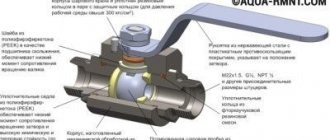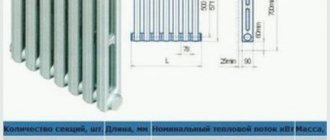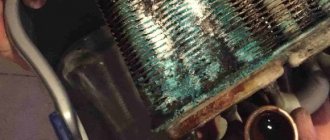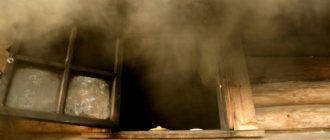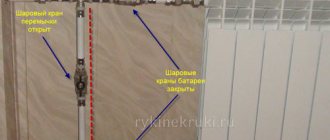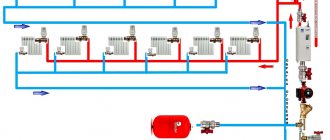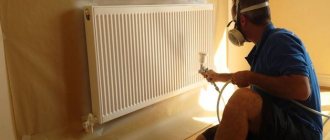The heating season is already beginning, and with it comes the annual problems: cold “radiators” in apartments. Specialists from ROYAL THERMO, one of the recognized leaders in the production of high-quality radiators, have compiled a top list of reasons why heating devices refuse to work. Perhaps he will help make the correct “diagnosis” and return the long-awaited comfort to your home.
“To find out exactly what happened to your heating devices and correct the situation,” says Yulia Zvyagina, technical specialist at ROYAL THERMO, “in most cases you need the intervention of a professional. Therefore, before purchasing a radiator, try to eliminate future troubles in advance.”
Let us note right away: before blaming the radiator for the malfunction, you need to make sure that the reason does not lie in “under-fueling” due to the fault of the utility workers. To do this, you just need to ask your neighbors - if they are also cold and the heating of the heating riser pipe is the same throughout the house, then you need to demand the truth from your management company or HOA. If other apartments are warm, but the riser is hot, then the problem is really in the battery. And we can name five main reasons for this situation.
1. Air lock. In general, this is the simplest and most common reason for the lack of heat, which is also the easiest to eliminate. If, when filling the radiator, an air bubble forms in its upper part, it can, like a plug, completely block the circulation. Dealing with this problem is quite simple: radiators are equipped either with a special tap, which you just need to open and bleed off the air, or with the so-called “Maevsky taps” - a needle air valve. You need to press it counterclockwise with a regular screwdriver and also wait for the bubble to come out. In any case, when performing these manipulations, it is worth placing a container under the radiator for draining water - this will protect the floors.
2. Debris in the radiator manifold. As you know, the quality of the coolant in most domestic networks leaves much to be desired. The liquid is often highly mineralized due to constant replenishment with untreated water, and worn-out pipelines also add a suspension of rust and scale. All this dirt inevitably settles on the walls of the radiator, narrowing the passage, impairing the thermal conductivity of the walls and disrupting circulation. But even if the coolant is free of flaws, contamination can appear due to the poor quality of the heating device itself. “For example, uneven filling of a steel collector with aluminum, which is often found in cheap no-name models and fakes, will inevitably lead to corrosion,” explains Yulia Zvyagina, technical specialist at ROYAL THERMO, “and its products will definitely end up on the walls of the collector, which, naturally, will negatively affect the operation of the device." Unfortunately, if there is debris and deposits, the battery will have to be removed and washed or, in advanced cases, replaced with a new one.
3. The radiator is not connected correctly. This is quite easy to determine: if only part of the device is heated (the top is hot and the bottom is cold or vice versa; only a few sections are heated), this is your case. Most likely, the wrong type of connection has been selected (the relative position of the coolant inlet and outlet). There are three of them in total: diagonal, bottom and side. The first is the most effective and will ensure uniform heating of the device. If hot water enters and leaves from below, then most often it simply does not have time to warm up the top. In this case, it is necessary to install a liquid flow extension - this is a pipe that allows the water to “linger” in the collector, heating it more evenly. With a side connection (both pipes on one side of the battery), usually only the first 3-4 sections have time to heat up. In this case, you will have to call a specialist and reconnect the radiator.
4. Communal problems. Firstly, it is the presence of a single-pipe heating system. Unfortunately, since Soviet times, most old apartment buildings have been equipped with this system. Due to technological features, the further a modern radiator is from the heating riser, the colder it will be. Secondly, the pressure in the system is too low. Usually associated with the deterioration of the infrastructure of old houses or design errors. Alas, in this situation only a major overhaul with a complete rework of the circuit will help.
5. Incorrect installation of the thermostat. Saving rapidly rising heat with the help of thermostatic heads is a good thing, but requires a qualified approach. If your neighbors installed such a thermostat and did not take care of the bypass pipe (it will ensure the circulation of hot water, even if the neighbor’s “battery” is completely blocked), the cold in your apartment is inevitable. Therefore, you need to boldly go to them and find out what and how. If there is no such pipe, require alteration. If they refuse, go to the management company or homeowners association, where they will be forced to make this modification forcibly.
So, we tried to find out why the heating season began, but there was still no heat. And since the causes of the problem are clear, you need to try to solve them - on your own or with the help of a specialist. The main thing is not to give up!
Royal Thermo is one of the largest manufacturers of radiators and components for heating systems, successfully represented on the Russian market since 2002. During this time, more than 25 million products under the Royal Thermo brand were sold. Since 2010, Royal Thermo has been cooperating with the Italian concern Faral, one of the market leaders, which in 1966 revolutionized domestic heating by starting to produce the world's first cast aluminum radiators. Many years of experience, a highly specialized focus of production, the introduction of innovative technologies and revolutionary design solutions have enabled Royal Thermo and Faral to develop a unique range of aluminum and bimetallic radiators aimed at the market in Russia and the CIS countries.
Powerful scientific and technical potential and market knowledge allowed Royal Thermo to create an ultra-modern production holding with headquarters and its own design studio in the province of Vicenza, and with factories in Italy (Orgiano) and Russia (Kirzhach, Vladimir region).
At a factory in Italy, RoyalThermo produces premium designer radiator models, professional piping and heating system elements. The Russian plant in the Vladimir region is designed for the annual production of more than 12 million sections and specializes in the mass production of high-tech models of radiators and components for energy-efficient construction. A multi-stage quality control system at all stages of production allows us to produce high-tech products (more than 10 international patents) with excellent thermal and strength characteristics. The production of radiators is certified in accordance with the international standards ISO 9001, ISO 14001.
Royal Thermo – made by the experts!
The battery does not heat in a private house
The reason why batteries in a private home do not heat up may be a number of factors. We can only consider the question in general. There are different reasons and they are not always obvious. Sometimes such a small thing as a faulty faucet or a clogged chimney can become a stumbling block. Despite this, there are no hopeless situations, the main thing is to determine the reason why the battery in a private house does not heat, the rest is a matter of technology.
Insufficient boiler power
If the radiators in a private house do not heat well, then one of the reasons may lie in the heating boiler. In your home, you can say with almost 100% probability that the heating circuit is autonomous. So the boiler is standing. It could be:
Why do batteries heat poorly in a private home? The reason may be an incorrectly selected boiler power. That is, it does not have enough resources to heat the required amount of liquid. The first sign that the power has been selected incorrectly is the constant operation of the heating device, without shutdowns.
Although in this case the heat exchangers will heat up at least a little. And if the water in them is completely cold, it means that the boiler is broken or cannot turn on. Modern units have a minimum pressure requirement in the system. If this requirement is not met, it will not turn on. In addition, there is an automation and security system.
Let's take, for example, a gas boiler. It contains a sensor that monitors that all gases go into the chimney. It is possible that the chimney or some smoke outlet pipe is clogged. In any case, the sensor will send a command to the control unit and it will not allow the boiler to turn on.
Here you will find information on how to repair a heating radiator with your own hands.
Clogged water filter of the heating system
Sometimes there is an arbitrary decrease in the temperature of the “last” battery in the row. Then it is possible to cascade shutdown of other batteries in front of it. Typically, the reason for such an “abnormal” decrease in temperature is the filters of the heating system. This filter must be removed and cleaned thoroughly. During the first start-up, there may be debris in the water that is pumped into the heating system. To prevent this debris from entering the heating boiler heat exchanger, a filter is installed on the return pipe in front of the boiler. Usually one such filter is installed, but sometimes you can see several installed almost in front of each battery. This setup doesn't make any sense. After cleaning, the radiators in the house will no longer be cold.
Problems with the batteries themselves
The batteries in a private house do not heat up, what should I do? If no problems are found with the boiler and it is working correctly, then the reason why the batteries are cold should be looked for in the circuit itself. Possible options:
- airing;
- pollution;
- insufficient pressure;
- incorrect pipe routing;
- Incorrect connection of heat exchangers.
If the batteries are cold, then you need to check all the above factors. More details about what to do if the batteries do not heat up
we already wrote. The specificity of a private house is that all characteristics can be controlled independently.
You need to check the circuit for air pockets. There are special taps and air vents for this.
Then make sure there is no dirt in the pipes and heat exchangers. How to do it? You will have to drain water from cold radiators in a private house. What to do is known, you need to unscrew one end (bottom) of the battery and substitute a larger vessel. If black water flows, then there is nothing to think about - this is pollution. It is necessary to rinse the circuit to clean water. Sometimes thick liquid flows out of radiators along with water. This is dirt collected in copious amounts.
What other reasons could there be for cold radiators in a private home? If the problem is not air or pollution, then circulation is broken. This may be due to low blood pressure. In general, in an autonomous circuit the coolant pressure does not exceed two atmospheres. If you have new batteries, then look at their data sheet. In modern heat exchangers, the operating pressure requirements are higher than in Soviet models. Pay attention to this.
If you want to repair the heating systems of a country house with your own hands, then this is the place for you.
Warmth on the balcony
To avoid problems with utility services, you need to think in advance about how to heat the balcony and make adjustments to the redevelopment approval project. There are several ways to make your own heating on the balcony; in the table we will look at the pros and cons of each option.
| Types of heating | Advantages | Flaws |
| Oil heater and convector for the balcony, electric | in fact, this is an improved battery, identical to the one used in the off-season.1. Fast warm-up.2. Silence.3. Work safety.4. Quick installation. |
5. Equipped with an overheating protection system.
Important: You cannot use gas or solid fuel heaters on the balcony!
Disruption of coolant circulation
What other reasons could there be for cold radiators in a private home? If the problem is not air or pollution, then circulation is broken.
Poor circulation can lead to unpredictable results.
We will separately consider the disruption of coolant circulation due to improper pipe routing and piping of heat exchangers, as a result of which the batteries are cold. In your home, you are free to choose the method of pipe routing. It could be:
- two-pipe heating system;
- single-pipe heating system.
It so happened that many people previously preferred a single-pipe heating system, also known as “Leningradka”. It was believed that it was simpler and cheaper, but in reality this is not the case. In addition, in this scheme it is very difficult to regulate the temperature of the heat exchangers as they move away from the boiler room. The farther from the boiler, the more sections there should be. Therefore, it is not uncommon that the last battery in a private house does not heat. The coolant flows through one pipe. In such a scheme there is no return.
It turns out that water enters the heat exchanger, cools there and is again drawn into the general flow. Accordingly, after each radiator the overall flow becomes colder. The difference increases with distance from the heating element. As a result, the water may reach the extreme heat exchanger almost cold.
In a two-pipe system, errors may be made in the piping:
- incorrectly installed shut-off valves;
- incorrect connection of the heat exchanger (there are three types: side, bottom, diagonal);
- The diameter of the bends is incorrectly selected.
For these reasons, circulation is disrupted and a negative result is obvious, namely a cold battery.
Insulating a home - materials, technologies, tips
After abandoning central heating and switching to autonomous heating, one drawback was noticed: in one of the rooms, with ten sections of the radiator, only 2 warmed normally, all the rest were only a little warm.
I replaced the old cast iron batteries with new aluminum ones. The advantages of aluminum radiators are that they are lightweight, heat up quickly, have a beautiful appearance, quick installation, and do not require painting. The disadvantages include rapid cooling.
Why doesn't my new aluminum battery heat up completely? The first thing that came to my mind was that maybe something had gotten in there and was preventing water from circulating in the radiator. But after studying this issue in detail, I found the reason. Everything turned out to be quite simple. The supply and return lines were reversed. That is, the supply was carried out from below, and the return was discharged from above.
The radiator heating circuit was approximately as follows:
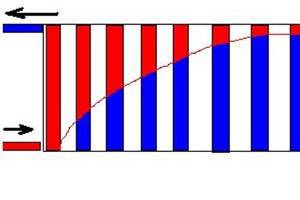
What the hell did the specialists in installing individual heating come up with?
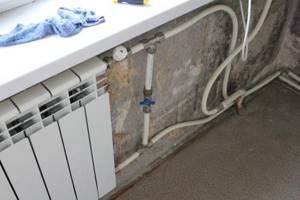
They installed an additional tap on the lintel near the battery. But this decision yielded virtually no results. And the consequences of this can be colossal, including failure of the boiler, if someone closes this valve and the battery at the same time.
How did I solve this problem? I took it and changed the supply and return in some places.
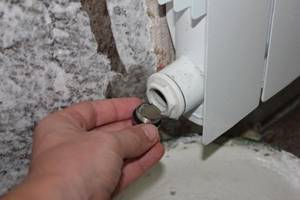
To do this, you need to drain the water from the heating system, which is done by unscrewing the bottom plug on the radiator. Unscrew it gently and slowly, since there is a pressure of up to 2 atmospheres in the system. You need to place some container underneath.

Then, in one of the sections of the heating pipeline, I dismantled the pipes and swapped them. I pumped water into the system and did a test run.
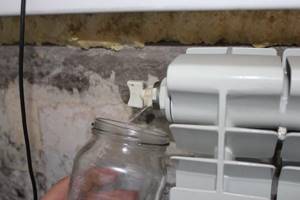
I deflated the air and drained 200 grams of water to fully ensure that all the air was gone. And now the radiator began to warm up completely and evenly. And I almost went to the store to buy a new one.
It has already become common for us to live in a warm house all year round, regardless of the temperature outside the window. The heating system, which everyone usually forgets about, maintains comfort, but as soon as the temperature drops, they remember its existence. If your home is cold, our article will help you figure out why the radiators are not heating.
Shut-off valves do not work
Shut-off valves regulate and shut off the operation of the coolant. This includes ball valves, cone valves, thermal heads with electronic and mechanical control.
By the way, experts advise installing thermal heads on each radiator. So, you can regulate the temperature in each individual room. If you configure the system correctly and select the temperature wisely, you will save up to 30% on heating.
On the tap you can observe an arrow that indicates the correct direction of movement of the coolant. If taps or valves are installed incorrectly, circulation will be disrupted. In addition, for proper operation, the damper must be closed.
A malfunction in one of the elements in the shut-off valve disrupts the circulation of the coolant. As a result, the bottom of the radiator or the battery becomes completely cooler. If the last battery is cold or the radiators at the top are warm and the bottom is cold, check the serviceability of the shut-off valves. If there are any defects, contact a specialist.
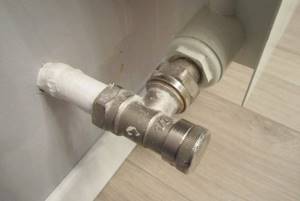
Where to contact
- Call the control room of the management company (MC) servicing your home. You can find its number in payment documents or on the information board at home. Check to see if any technical work is currently being carried out.
- If not, you should contact your neighbors in the riser; perhaps they have closed the circuit for repairs.
- If you are sure that the reason does not lie in your house or apartment, and the temperature is below the established standards, you have the right to call an engineer from the management company to draw up a report and eliminate the reasons.
Sample complaint to the heating management company

In order for a complaint about cold batteries to be accepted for consideration, and the causes of the incident to be eliminated, you must follow the writing rules:
- The complaint must be structured, written in legally competent language, without emotional overtones.
- Only facts that can be supported by evidence should appear.
- If a collective complaint is planned, then it should have as many signatures as possible. To do this, they hold a meeting of those living in the entrance or in the house and jointly discuss the initiative to create a claim.
- For further movement through the authorities, you will need proof of application. Therefore, the complaint must be sent by registered mail with notification by mail or brought to the reception office of the Criminal Code, register two copies and keep one for yourself.
What you can do yourself
- Check the thermostats and taps near the radiators; they may be closed.
- If your radiators are equipped with an air vent (Maevsky tap), try bleeding air through it. Unscrew it slightly: if there is a hissing sound, then the problem is an air lock. If water comes out immediately, this is not the problem.
- Radiators clogged with deposits. Old cast iron and modern aluminum models are especially susceptible to this. You can find out the presence of a blockage only by disconnecting the radiator or using a thermal imager; it is better to involve a plumbing specialist for this. In a private home, you can check the filters or flush the system under high pressure.
- Battery connection is incorrect. If newly installed radiators do not heat, then most likely they were connected incorrectly. This is especially possible with lower supply. Again, you will need a heating specialist to confirm the problem.
So, don't panic if there is no heat in the battery: it is likely that you can fix it yourself. In any case, using this guide, it is not difficult to find the reason.
A cold radiator at the height of the heating season is far from uncommon. This kind of trouble happens not only in an apartment, but also in your own home.
All batteries are hot at the top, but colder at the bottom. However, when the temperature difference is very large, this indicates a problem. After all, the radiator emits much less heat than planned.
Incorrect connection
If you connect the radiator incorrectly, this can lead to a drastic reduction in the heating efficiency of the room. As a rule, such mistakes are made by self-taught people, so it is better to hire professionals for installation. Otherwise, this may lead to the following problems:
- decrease in battery efficiency;
- change in the process of circulation and outflow of coolant;
- increased risk of corrosion.
If the radiator was connected incorrectly, the coolant penetrates into it through the lower pipe, then circulates in a circle and flows out of the battery. As a result, not all sections are heated, which negatively affects heating. When the coolant enters the heating device, it immediately rushes upward, since hot water has a higher density than cold water. As a result, the liquid travels the shortest possible path, warming up not every section. The problem can only be solved by dismantling the radiator and proper installation.
Problems with the radiators themselves
Why is the radiator hot on top and cold on the bottom and how to fix it?
The bottom of the battery is clogged with dirt
- At first in my apartment
. When they are warm, ask your neighbors. - When everything is in order with them and with the heating wiring, as well as with the radiators, it means that the problem is in your device.
- Most often, the reason is that it is clogged with dirt
- metal oxides (rust) and other suspended matter, which, when settled, do not allow the coolant to pass through. Therefore, the top of the radiator is hot and the bottom is cold. - Try warming up the battery in the problem area
. The water will boil there, begin to move, and perhaps the suspension will leave.
Note! Of course, a more effective way to clean the battery is to remove it and wash it. However, you cannot do this work yourself, because... you will have to disconnect the entire heating riser from the water. Housing office workers will refuse to do this in the winter cold. Therefore, the batteries should be washed in advance, before the start of the heating season.
Air in heating devices
Often batteries do not heat well, because... an air plug was created in them. It is formed when the coolant heats up and suddenly fills the heating system with it.
When the radiator is equipped with a release valve, it is not difficult to deal with the problem yourself.
- On modern types of batteries, this device is mounted at the top and functions autonomously, periodically bleeding off excess air.
- Manual valves are also often used. They should be unscrewed and kept in this state until water begins to flow.
- Old battery models do not have taps. But there is a stub.
- Place a basin under the radiator to prevent water from spilling onto the floors. Unscrew the plug until a hissing sound appears. Wait until all the air has escaped and water begins to ooze out. Next, screw the plug back on.
Incorrect installation of heating system elements
The following types of heating pipe connections are now common: diagonal analogue, bottom connection, side installation.
- The instructions now consider the diagonal type of connection to be the most effective.
- The connection is not correct when the coolant supply branch is connected to the bottom of the batteries. Then hot water flows in the lower part of the heating device and does not fully warm it up. Installing a water inflow extension can correct the situation here.
- Lateral connection is also ineffective. Then only the initial sections of the radiators warm up sufficiently, at most 4/6. In this situation, qualified plumbers will be able to help you.
Note! It is very common for the radiators on the top floors of apartment buildings to be hot, but downstairs they are lukewarm. Here the problem is obvious - illiterate design and installation of the heating system. You can’t handle this on your own; you will need to consult an independent heating engineer.
It should be noted that the number of sections in any type of heating system should not exceed the standard limit.
- When heating by gravity (gravity) the radiator should not have more than 12 sections.
- In forced circulation systems, heating devices should not be composed of more than 24 sections. Otherwise, the last of them will still not warm up.
Illiterate arrangement of an autonomous heating system
When arranging heating in your home, the question often arises as to why the last radiators in a two-pipe system are cold.
Why do batteries heat poorly in a private home?
In this case, the batteries may be cold from below, when the “return” and “supply” have been confused, or the coolant circulation rate inside the devices is not high enough.
- In the first case, everything is simple. The battery was incorrectly connected to the supply and return pipes of the heating system. Here it is enough to disconnect the radiator and connect it correctly, according to the heating diagram.
- When the radiator is hot at the top and cold at the bottom in the second case, it is explained as follows. When the coolant flows through the system at high speed, its elements will be hot everywhere. When the speed is low, the water gradually cools and becomes colder at the bottom of the radiators.
Insufficient coolant circulation
Insufficient coolant velocity occurs in such cases.
- When the internal diameter of the pipe is narrowed in any area.
- When the flow rate of the coolant is not high enough in principle.
A common reason for slow water movement is a low-power or faulty circulation pump. In the case of a gravity (gravity) heating network, it does not exist at all.
The internal cross-section of the pipes may unexpectedly decrease in such cases.
- Incorrect choice of control valve, with a narrowed inner diameter.
- Poor-quality soldering of plastic pipes, when internal sagging and burrs appear at the points of their connection.
- Deposits on the walls of pipes that do not allow the possible volume of coolant to pass through and slow down its flow (hydraulic resistance).
There is another situation when the bottom of the radiator is cold and the top is hot. This is when the room is not insulated (for example, a cold balcony, veranda). If the air temperature in the room is low, then the coolant in the radiator will cool faster.
When the upper battery pipe is heated and the lower one is cold, then the “return” and “supply” are not confused. Therefore, valves and pipes should be checked.
- If the battery has an adjustment valve, it is worth twisting it and checking it. If you find that its internal diameter is too narrow, you will need to install a valve with a sufficient flow area.
- When the heating pipes themselves have too small an internal diameter or their walls are clogged with deposits, there is nothing left to do but change them.
- There is another way out - install . However, this solution is not entirely correct, and its price is high.
The riser is blocked
The reasons when the riser in a multi-storey building is blocked affect all residents who live in the “disaster area”. In fact, unauthorized blocking of the riser can be done by one of the residents out of ignorance. In any case, with such an overlap, there is a need for the intervention of regular plumbers to clarify and fix the problem. Of course, this causes the batteries to become cold.
More frequent causes of a blocked riser occur after any repairs have been carried out that required such a blocking. Each riser of a multi-apartment multi-storey building is equipped with shut-off valves at the top and bottom. Carrying out repairs in which both the upper and lower taps are closed requires special permission.
At the end of the repair, the specialists could simply forget to turn the riser back on to normal mode. If, in the user’s opinion, the riser is blocked, then you should contact the relevant organization and find out the details. You should not attempt to restore the riser operation without permission.


